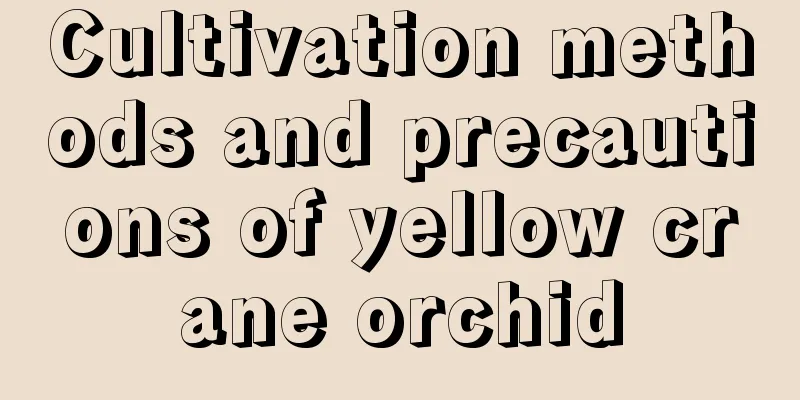Cultivation methods and precautions of yellow crane orchid

Soil managementPotted yellow crane orchid is suitable for relatively loose, fertile and well-drained soil, preferably fertile soil with a high humus content. You can use some leaf mold, garden soil, pond soil, etc. which contain a lot of nutrients. Make sure to keep the soil moderately moist to facilitate plant growth. Temperature ManagementThe temperature suitable for Yellow Crane Orchid is about 18-25℃. This flower is relatively cold-resistant, but the temperature in winter should be kept above 6℃ as much as possible. Lighting ManagementYellow crane orchid prefers a relatively warm and humid environment, and grows best in a semi-shaded space. Be careful to avoid direct sunlight. When the sun is strong in summer, appropriate shading should be carried out to avoid sunburning the leaves. Generally speaking, blocking about 50% of the light is sufficient. If conditions permit, you can plant the crane orchid directly under the shade of a tree or in a tall flower bush. Moisture ManagementThe crane orchid likes moisture and is not drought-tolerant. It needs more watering during its vigorous growth period, but water accumulation in the pot should be avoided. In summer, it is especially important to maintain the humidity of its growing environment. In addition to maintaining the moisture of the soil, you should also frequently sprinkle water around the flowers to increase the humidity of the surrounding air. After the peak flowering period, the crane orchid will begin to enter a short dormant period. At this time, the root function of the plant declines and the absorption capacity is greatly weakened, so it is necessary to control watering and reduce the amount of water. When the air is dry, spray water on the leaves frequently to keep them moist. Fertilizer managementDuring the growing period of the crane orchid, fertilizer should be mainly decomposed organic fertilizer, and light liquid fertilizer should be applied every two to three weeks. Before the flowering period arrives, fertilizer should be changed to phosphorus fertilizer and potassium fertilizer as the main fertilizer. After the flowering period, the remaining flowers should be cut off in time to reduce the loss of nutrients. Stop fertilizing after the temperature drops in autumn and winter. Pest controlCommon diseases and pests of crane orchid include white rot, anthracnose, scale insect pests, etc. These pest and disease problems are particularly likely to occur in the hot and humid environment in summer. Therefore, we must pay attention to prevention during daily maintenance. In addition to regular sterilization and pest control, it is more important to create an excellent environment suitable for plant growth, eliminate the main causes of diseases and pests, and eliminate diseases and pests fundamentally. |
<<: Cultivation methods and precautions of Xiaozhuya
>>: The difference between Gloxinia and Hibiscus
Recommend
Cultivation methods and precautions of feather-leaf iris
Featherleaf morning glory is a very easy-to-grow ...
Can volcanic rocks be used to grow succulents?
Can volcanic rocks be used to grow succulents? Su...
How to grow the Dancing with Grace to make it bloom
The Dance of Gagaku Blossoms The Dancing Plant ra...
What to do if the leaves of Christmas cactus become soft and wrinkled
1. Water appropriately Cause: This phenomenon is ...
How many times a year does chrysanthemum bloom?
Aster is a perennial herbaceous plant of the genu...
What is the reason for the yellow leaves of Christmas cactus and what is the remedy
1. Too much light Reason: Although it likes light...
Where is the gourd suitable for growing?
Gourd growth habits The gourd is a plant belongin...
Is Phalaenopsis suitable for a large or small pot?
Phalaenopsis, should I use a large or small pot? ...
A comprehensive review of the Feng Shui of Lucky Bamboo. If you don't understand it, you will suffer a great loss.
The placement of lucky bamboo 1. Place it on the ...
How to plant Clivia? Cultivation methods and steps for newly bought Clivia
The leaves of Clivia are emerald green and look v...
How to prepare soil for Jade Dew
1. Soil preparation requirements The climate in t...
When is the rice harvested?
Rice is a very important economic crop in my coun...
White melon planting technology and management
White melon is a common variety of melon. It has ...
How to grow hibiscus in the garden
Planting and fertilization of garden cultivation ...
How to deal with the flower stems of Phalaenopsis flowers after they have bloomed (treatment and maintenance techniques for the flower stems after the flowers have faded)
How to deal with and care for Phalaenopsis after ...









